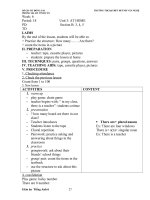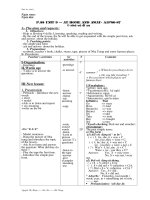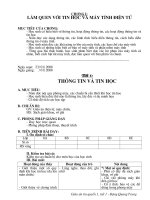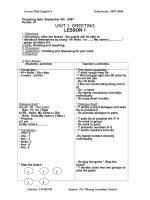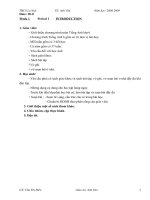Giáo án Anh 6 tiết 91-105
Bạn đang xem bản rút gọn của tài liệu. Xem và tải ngay bản đầy đủ của tài liệu tại đây (202.37 KB, 19 trang )
Date of Planning :…/ … /20… Date of Teaching: … /…/20…
UNIT 15: COUNTRIES
Period: 91 LESSON 1: WE ARE THE WORLD (A 1,2,3)
I. Objectives: By the end of the lesson, students will be able to describe Vietnam using “
lots of…” as a quantifier with the geography vocabulary.
II. Ways of working: pair work, individual work, …
III. Material: - book, planning, picture, stereo, tape,
IV. Procedure:
A.Class organization:
B.Old lesson:
C.New lesson
1. Warm up. Slap the board.
beautiful lakes mountain
Beaches green field Rivers
2. Presentation: T & Sts activities.
- Pre teach vocabulary by using pictures and explanation.
* Vocabulary:
- a country :
- a nationality :
- a language :
- (to) speak :
* Check vocabulary by asking Ss to read the text and work out the country name in
Vietnamese (use the pictures in the textbooks).
English Vietnamese
Japan
China
Australia
Britain
Canada
- Gives feedback.
- Elicit the new structure to talk about where people are from.
- Model the structure. Model sentences:
Where is she from?
are you
- Check concept it She’s from Canada.
I’m
- 1 -
3. Practice: Sts activities.
- Use pictures in the textbook, gets Ss to practice the exchanges in pairs
- Example exchanges:
S1:Where’s (Laura) from?
S2: She’s from (Canada).
4. Further practice: Sts activities.
- Introduce the language contents in A
2
and A
3
page
- Get Ss to write dictation list.
- Teacher reads: Japanese, Canadian, Vietnamese, Chinese, Australian, British
Answer key
ese an ?
Japanese
Chinese
Vietnamese
Canadian
Australian
British
French
- Ask Ss in pair to practice talking about where they from, their nationality and their
language in real life.
- Example exchanges:
S1:Where are you from?
S2: I’m from Vietnam.
5. Consolidation T activities.
D. Homework.
- Ask Ss to copy the homework in to their notebooks
- Make a dialogue about your intend
- Learn the lesson carefully.
- Prepare A 4, 5, 6
- 2 -
Where + be + S + from?
S + be + from + Quốc gia
Date of Planning :…/ … /20… Date of Teaching: … /…/20…
UNIT 15: COUNTRIES
Period: 92 LESSON 2: WE ARE THE WORLD (A 4,5,6)
I. Objectives: By the end of the lesson, ss can be able to write a postcard about being on
vacation.
II. Ways of working: pair work, individual work, …
III. Material: - book, planning, picture, stereo, tape,
IV. Procedure:
A. Class organization:
B.Old lesson: Make 5 sentences to say the sports which the people in your family like
C.New lesson
1. Warm up . Slap the board
2. Pre writing: T & Sts activities
- Ask Ss to present a dialogue basic on A
4
P.156 by using the information from A
2,3
P.155.
- Ask them to practice out in class
- Example dialoguage:
Thu: Who’s that?
Chi: That’s (Laura).
Thu: Where’s she from?
Chi: She’s from (Canada).
Thu: What’s her nationality?
Chi: She’s (Canadian).
Thu: Which language does she speak?
Chi: She speaks English and French.
- Ask Ss in pair to practice talking about where they from, their nationality and their
language in real life.
- Vocabulary A 5
- a postcard :
- (to) be on vacation : trong kì nghỉ
- wet (adj)
- a lot of = many:
- interesting places :
- Check vocabulary by ROR
- 3 -
Canada
Bristish
Australia
Japan
China
Viet Nam
France
3. While writing: Sts activities.
- Ask ss to read and answer the questions in pairs
- Comprehension questions
a) Who’s the postcard from?
b) Where is he?
c) What’s the weather like?
d) Is he travel by train?
e) What is he going to go tomorrow?
f) Who’s the postcard to?
g) Where is he?
- Divide class in to 6 groups, deliver paper and pen then show cues for them to write.
- Model post card (in the text book)
- Ask ss to put their written postcard on the board.
Dear …………
I’m on vacation in …………
- T. asks sts to work in groups.
- Sts discuss and give the answers.
4. Post-writing: T & Sts activities
- Correct the ss’ written postcard.
5. Consolidation:
- T asks Sts answer the questions A 6 P. 157
- Pair work
- Give feedback.
- T correct.
D. Homework.
- Learn the lesson carefully and structure.
- Write a dialouge using the structure in the lesson.
- Prepare B 1,2,3, 4
- 4 -
Date of Planning :…/ … /20… Date of Teaching: … /…/20…
UNIT 15: COUNTRIES
Period: 93 LESSON 3: CITIES, BUILDINGS AND PEOPLE.
(B 1,2,3,4)
I. Objectives: Ss will be able to compare places using comparative and superlative
adjectives of one syllable.
II. Ways of working: pair work, individual work, …
III. Material: - book, planning, picture, stereo, tape,
IV. Procedure:
A. Class organization:
B. Old lesson:
C. New lesson
1. Warm up. Revision
- Puts the exercise "matching" on the board, asks ss to choose the adjectives which best
describe the cities (a city can have more than one adjective).
- Match the cities with the adjectives. Matching
Hue hot
HCMC wet
Hoi An big
Sa Pa cold
Ha Noi small
Da Lat cold
2. Presentation:
- Reads the text and ask ss to listen and repeat
- Introduces the new grammar point
- Grammar point ( comparative and superlative adjectives)
1. (+ er)
Ex: small → smaller → smallest
2. (double last letter + er)
Ex: big → bigger → biggest
- Look at their textbooks B
1
, listen and repeat
- Copy
3. Practice: Sts activities.
- Put the cues on the board, models and gets ss to practice in pairs
- Word cue drill:
Da Nang / Ha Noi / HCMC Ha Noi / Uong Bi / Sa Pa
Vinh / An Giang / Ben Tre Hue / Quang Ninh / Buon Ma Thuot
- Example exchange:
S1: Ha Noi is bigger than Da Nang
S2: But HCMC is the biggest.
- Controls and help weaker ss.
- 5 -
- Calls some pairs to check
4. Pre-reading: Sts activities B2 P.159
- Pre- teach vocabulary:
- high (adj) : - long (adj) : - thick (adj) : - over:
- a million : - population : - the capital:
- T elicits the new words by “example” and “explanation” technique. Asks Ss to copy.
- T checks vocabulary by technique “Slap the board”.
- T give 5 places & get Ss to guess what places have the biggest population (order them fellow a
scale).
5. While-reading: Sts activities
- T gets Ss to open their books, read and check their prediction.
- Answer key: bigger …….
Mexico city Tokyo London HCMC Ha Noi ………… ← smaller
- Guess from the context. B2 P.159
- Directs Ss to took at the picture and the content and guess the meaning of the words.
* Comprehension questions a) e) P.159
a) Is HaNoi bigger than Ho Chi Minh city? b) Which is the biggest city in the world?
c) Which is bigger: London or Tokyo?
- Feedback. - Make questions and elicits Ss to answer.
- Corrects the wrong answers.
6. Post-reading: Sts activities B3 P.159
- Guide the ss answer the question ans how to make up the question from the answer
- Divides ss in pairs , gives some cues and gets Ss follow the text to make questions.
* Guessing meaning from the contest
- a building : - a structure : - meters : - a kilometers :
- Calls some pair to check their work.
* Question in B3 : Which is taller: Sear Tower or Petronas Twin Tower ?
The Petronas Twin Towers.
7. Conlidation : T. remind the main structure:
a) It’s over 6000 kilometers. e) 12 million
How long is the Great Wall? What the biggest city in the word?
b) It’s between 4 and 12 maters high. f) 452 meters
How high is the Great Wall? How high is PETRONAS Twin Tower?
c) It’s over 9 meters thick. g) The great wall
How thick Great Wall? What’s the longest structure in the word?
d) Mexico city
- 6 -
population
the capital
high
thick
million
over
What’s the population of Tokyo?
D. Homework. - Asks sts to copy the homework in to their notebooks.
- Learn the lesson carefully. Prepare C 1
Date of Planning :…/ … /20… Date of Teaching: … /…/20…
UNIT 15: COUNTRIES
Period: 94 LESSON 4: NATURAL FEATURES (C 1)
I. Objectives: Ss will be able to:
- use “Lost of” answer a quantifier with Geography vocabulary to describe
Vietnamese.
- Ss are Vietnamese they should know a lot a bout their country and can
describe. It to S.O
II. Ways of working: pair work, individual work, …
III. Material: - book, planning, picture, stereo, tape,
IV. Procedure:
A.Class organization:
B.Old lesson:
C.New lesson
1. Warm up. Revision
- Collects the vocabulary from Ss and divides class in two teams to “Slap the board”.
- Slap the board
2. Presentation: Sts activities
- Pre- teach vocabulary
- a forest: - a desert:
- rain: - great: - lots of:
- Eliciting with picture and explanations
- Checking by “What and Where”
- Present the text
- Set a scene
- Reads the text and gets Ss to repeat.
- Gets Ss in pairs to discuss to predict six features “that Lan tell us about”
3. Practice: Sts activities
- Gives example and gets Ss to practice in pairs. ( using pictures a) g)
- C
1
P.162 – 163
*B Comprehension questions
(What are six natural features Lan tell us?)
- Answer key:
1- moutains 2- rivers 3 - lakes 4- rain 5- forest 6- beaches
- Calls some pairs to check.
- 7 -
Beache
s
Lake
Beautif
ul
Mountai
ns
River
Field
- Corrects the common mistakes.
- T read the sentences
- Model sentences
mountains/ rivers (cout)
We have
lots of rain (un.c)
* Picture drill
- Example exchange
S
1
: Does Vietnamese have a lot of [mountains]?
S
2
: Yes, it does.
* True / False Repetition drill
1. They are lots of beaches in DaNang.
2. There are lots of forests in Ha noi.
3. There are lots of lakes in Ha Noi.
4. There are lots of mountains in Da Lat.
5. There are lots of fields in HCMC.
6. There are lots of people in HCMC.
7. There is lots of rain in VN.
8. There is lots of rain in desert.
- Asks ss to listen and repeat if they are true and silent if they are false.
- Answer key: 1.repeat 2. silent 3. repeat. 4. repeat
5. silent 6. repeat. 7. repeat. 8.silent
- Check their work.
4. Production: Sts activities.
- Matching
Lai Chau lakes
Can Tho forests
Ha Noi mountains
Pleiku beaches
Da Nang rain
- T gets Ss to writes a short paragraph to describe their country follow these cues.
- Write it up
My country is very beautiful. In LaiChau there are lots of forests …
5. Conlidation :T activities.
- Remind the natural features in Viet Nam
D. Homework.
- Learn the lesson carefully.
- Write a passage to tell about your intend
- Prepare C 2,3
- 8 -
Date of Planning :…/ … /20… Date of Teaching: … /…/20…
UNIT 15: COUNTRIES
Period: 95 LESSON 5: NATURAL FEATURES (C 2,3)
I. Objectives: - Ss can read and understand a good passage.
- revise yes – no question with ordinal verbs.
II. Ways of working: pair work, individual work, …
III. Material: - book, planning, picture, stereo, tape,
IV. Procedure:
A.Class organization:
B.Old lesson:
C.New lesson
1. Warm up. Play: Noughts and crosses.
- T. draws a table with words in the lesson.
- Divides class into two teams. One team is Noughts(O) and the other is Crosses(X).
- Two teams choose the words in the boxes in turns.Then use the adverb of frequence. If
the sentence is correct, they will get two marks.
-The team which has 3 noughts or 3 crosses on a line will win the game.
1
forest
2
desert
3
citadel
4
beach
5
rain
6
mountain
7
river
8
field
9
bay
2. Pre - reading. Sts activities
- T. explains the way to do C3-P165.
- T uses pictures or items to help sts remember words.
- flow (into) - the Gulf of Tonkin : Vịnh Bắc bộ - Tibet : Tây Tạng
- Nile river - North Africa - the Mediterraneace Sea. - Mount Everest
- Check vocabulary: ROR
- Structure comparative and superlative adjectives
3. While - reading: Sts activities.
- Sts look at the book and listen to C3-P165.
- Asks sts to answer the questions in C3 P165 (Work in pairs)
- Give feedback.
- T correct.
4. Post reading. Sts activities.
- Asks sts to check True or False questions.
- Give feedback.
- T correct.
5. Conlidation: Sts activities.
- 9 -
Remind the comparative and superlative adjectives.
D. Homework. - Learn the lesson carefully.
- Prepare unit 16 A 1,2
Date of Planning :…/ … /20… Date of Teaching: … /…/20…
UNIT 16: MAN AND THE ENVIRONMENT
Period: 96 LESSON 1: ANIMALS AND PLANTS (A 1,2)
I. Objectives: - Ss can talk about food using countable and uncountable quantifiers.
- read and understand the text about farming.
II. Ways of working: pair work, individual work, …
III. Material: - book, planning, picture, stereo, tape,
IV. Procedure:
A. Class organization:
B. Old lesson:
C. New lesson
1. Warm up. Revision
Toespota (potatoes) Werflos (flowers) Gegs (eggs)
Icer (rice) Nonies (onions) Motaotes (tomatoes)
Tablesveges (vegetables)
2. A1.1. Presentation: Sts activities
- Presentation text A1 P166
* Model sentence:
-How much rice is there?
-There’s some
a lot of = (lots of) rice
a little
- How many eggs are there?
- There are some
a lot of | lots of | eggs
a few
- Check vocabulary: ROR
- Structure comparative and superlative adjectives
A 1.2. Practice: Sts activities.
- Matching A3 P167
(nb: the tapescript in the teacher’s book is wrong. Read this aloud instead)
- Picture drill
A1 P166 A3-167
- Example exchange
S1: How much (rice) is there?
S2: There’s (a lot)
S1: How many (onions) are there?
S2: There are ( a few)
“ What’s for dinner?”
- 10 -
Example
S1: There’s a little rice
S2: There’s a little rice and some tomatoes
S3: There’s a little rice, some tomatoes and a few…
S4: etc…
- Give feedback.
- T correct.
3. A 2.1 Presentation: Sts activities
* Pre teach:
On the farm: ở trang trại
A buffalo: con trâu
A cow: con bò cái
(to) plow: cày
(to) pull a cart: kéo xe bò
(to) grow: trồng
(to) produce : sản xuất
* Open prediction:
- Students predict 6 things MR Hai has on his farm and 5 things he proceduces
- Mr.Hai has proceduces
A 2.2. While reading:
- A2 P166 (ignore” a dog and a cat”)
- Students checks their prediction
- Comprehension questions: A2 P167 a→e
- Grids (with key)
A 2.3 Post reading:
- Board drill
- Use the grid above for cues for the drill.
Hai has/
grows/ proceduces….
A lot Some A
few
A
little
Paddy fields
Rice
Vegetables
Fruit trees
Fruit
Animals
Buffalo
Cows
Milk
Chickens
eggs
√
√
√
√
√
√
√
√
√
√
√
√
- Example exchanges:
S1: How many (paddy fields) does the Mr Hai (have)?
S2: (some)
S1: How much (rice) does the Mr Hai (produce)?
S2: ( a lot)
- 11 -
4. Conlidation: Sts activities.
Remind the work of farmer.
D. Homework. - Learn the lesson carefully.
- Prepare unit 16 A 3,4
Date of Planning :…/ … /20… Date of Teaching: … /…/20…
UNIT 16: MAN AND THE ENVIRONMENT
Period: 97 LESSON 2: ANIMALS AND PLANTS (A 3,4)
I. Objectives : By the end of the lesson, students can use the questions “ why ?” “ Because …”
II. Ways of working: pair work, individual work, …
III. Material: - book, planning, picture, stereo, tape,
IV.Procedures :
A.Class organization:
B.Old lesson:
C.New lesson
1. Warm up. Play: Noughts and crosses.
- T. draws a table with words in the lesson.
- Divides class into two teams. One team is Noughts(O) and the other is Crosses(X).
- Two teams choose the words in the boxes in turns.Then use the adverb of frequence. If
the sentence is correct, they will get two marks.
-The team which has 3 noughts or 3 crosses on a line will win the game.
1
tomatoes
2
patatoes
3
onions
4
rice
5
fish
6
vegetables
7
flowers
8
chicken
9
noodles
- T asks sts listen to match and write the
letter of the pictures.
- Give feedback
- T correct.
- 12 -
2. Pre - reading. Sts activities
- T. explains the way to do C3-P165.
- T uses pictures or items to help sts remember words.
( pollution - grow- land - cut down - burn - destroy - animals - danger )
- Check vocabulary: ROR
- Structure Why …? – Because
3. While - reading: Sts activities.
- Sts look at the book and listen to A 4-P168.
- Asks sts to answer the questions in A 4-P168 (Work in groups)
- Give feedback.
- T correct.
4. Post reading. Sts activities.
- Asks sts to check True or False questions.
- Give feedback.
- T correct.
5. Conlidation: Sts activities.
Remind the comparative and superlative adjectives.
D. Homework. - Learn the lesson carefully.
- Prepare unit 16 A 5
Date of Planning :…/ … /20… Date of Teaching: … /…/20…
UNIT 16: MAN AND THE ENVIRONMENT
Period: 98 LESSON 3: ANIMALS AND PLANTS (A 5)
I. Objectives :By the end of the lesson, students can use the questions “ Why…?”“ Because …”
II. Ways of working: pair work, individual work, …
III. Material: - book, planning, picture, stereo, tape,
IV.Procedures :
A. Class organization:
B. Old lesson:
C. New lesson
1. Warm up. Play: Noughts and crosses.
- T. draws a table with words in the lesson.
- Divides class into two teams. One team is Noughts(O) and the other is Crosses(X).
- Two teams choose the words in the boxes in turns.Then use the adverb of frequence. If
the sentence is correct, they will get two marks.
-The team which has 3 noughts or 3 crosses on a line will win the game.
1
Cut down
2
burn
3
animals
4
plants
5
danger
6
land
7
fields
8
population
9
grow
- 13 -
2. Pre - reading. Sts activities
- T. explains the way to do C3-P165 again.
- True or False prediction.
- Structure Why …? – Because
3. While - reading: Sts activities.
- Asks sts to check True or False prediction.
- Give feedback.
- T correct.
- Sts look at the book and listen to A 4-P168.
- Asks sts to answer the questions in A 5-P168 (Work in groups)
- Give feedback.
- T correct.
4. Post reading. Sts activities.
- Asks sts to disscuss how to protect the forests.
- Give feedback.
- T correct.
5. Conlidation: Sts activities.
Remind the comparative and superlative adjectives.
D. Homework. - Learn the lesson carefully.
- Prepare unit 16 B1,2, 4
Date of Planning :…/ … /20… Date of Teaching: … /…/20…
UNIT 16: MAN AND THE ENVIRONMENT
Period: 99 LESSON 4: POLLUTION (B 1,2,4)
I. Objectives :By the end of the lesson, students can know how to protect the pollution
II. Ways of working: pair work, individual work, …
III. Material: - book, planning, picture, stereo, tape,
IV.Procedures :
D. Class organization:
E. Old lesson:
F. New lesson
1. Warm up. Chatting
2. Pre - reading. Sts activities
- Asks sts look at the picture p. 169 and listen then answer the questions.
- Vocabulary: pollution, environment, wild, waste, air, gas, oil, power, trash, oceans, put
sth in, take sth , leave, can, grass, pick, damage, keep sth off …
- Check vocab: ROR
- T. explains the way to do B1-P169 again.
- True or False prediction.
- Structure should + V_infinitive.
3. While - reading: Sts activities.
- Asks sts to check True or False prediction.
- Give feedback.
- 14 -
- T correct.
- Sts look at the book and answer quetions to B1-P169.
- Asks sts to answer the questions in B1-P169 (Work in groups)
- Give feedback.
- T correct.
4. Post reading. Sts activities.
- Asks sts to disscuss how to protect the pollution.
- Give feedback.
- T correct.
5. Conlidation: Sts activities.
Remind the modal verbs with “should”.
D. Homework. - Learn the lesson carefully.
- Prepare unit 16 B5,6
Date of Planning :…/ … /20… Date of Teaching: … /…/20…
UNIT 16: MAN AND THE ENVIRONMENT
Period: 100 LESSON 5: POLLUTION (B 5,6)
I. Objectives :By the end of the lesson, students can know how to protect the pollution
II. Ways of working: pair work, individual work, …
III. Material: - book, planning, picture, stereo, tape,
IV.Procedures :
G. Class organization:
H. Old lesson:
I. New lesson
1. Warm up. Revision. Hanging games
2. Pre - reading. Sts activities
- Asks sts look at the picture p. 172 and listen.
- Vocabulary: pollution, environment, recycle, feed, pigs, empty bottle, scrap metal, plastic,
use, all …
- Check vocab: ROR
- T. explains the way to do B5,6-P172.
- True or False prediction.
- Structure should + V_infinitive.
3. While - reading: Sts activities.
- Asks sts to check True or False prediction.
- Give feedback.
- 15 -
- T correct.
- Sts look at the book and answer quetions to B5,6-P172.
- Asks sts to answer the questions in B5,6-P172 (Work in groups)
- Give feedback.
- T correct.
- Asks sts to disscuss how to protect the pollution.
- Give feedback.
- T correct.
4. Post reading. Sts activities.
- Asks sts to play games “Lucky numbers”.
5. Conlidation: Sts activities.
Remind the modal verbs with “should”. And the environment’s pollution
D. Homework. - Learn the lesson carefully.
- Prepare unit Grammar practice
Date of Planning :…/ … /20… Date of Teaching: … /…/20…
UNIT : GRAMMAR PRACTICE
Period: 101 LESSON : GRAMMAR PRACTICE
I. Objectives : By the end of the lesson, students can do further practice in present simple and
progressive, comparalatives and superlatives. Quantifiers and countability, countries, antural
features, farming and environment.
II. Ways of working: pair work, individual work, …
III. Material: - book, planning, picture, stereo, tape,
IV.Procedures :
i.Class organization:
ii.Old lesson:
iii.New lesson
1. Warm up. Sts activities.
-Ask Ss to tell the names of the countries and their languages which they know.
- Ss do as teacher’s directed
-Give feedback
-Ask each student to think of his / her nationality and language.
-The rest of the class ask him / her to find out them.
2. Present simple. Sts activities.
1.Net work
- 16 -
Countries and
languages
2.Guessing game:(G.P 1)
Ex: I’m from and I speak
S1:Are you from China? S2: No, I’m not.
S3:Do you speak English? S2: Yes, I do
S4: Are you from Australia? S2: No, I’m not.
3. Present simple and present progrssive tense Sts activities.
*Mapped dialouge (G.P 2)
You Your friend
name?
live?
stay now?
do?
what teach?
teach you?
Susan
London
Ha Noi
teacher
Englis
No, Mr Hai.
* Example exchange:
S1:What’s her name?
S1:Where does she live?
S1:Where is she staying now?
S1:What does she do?
S1:What does she teach?
S2:Does she teach you?
S2: Her name’ s Susan.
S2:She lives in London
S2:She is stay in Hanoi.
S2:She’s a teacher.
S2:She teaches English
S2:No, she doesn’t. Mr
Hai teaches me.
4. Comparatives and superlatives Sts activities.
1.Completing the table
long longer the longest
short shorter the shortest
tall taller the tallest
small smaller the smallest
big bigger the biggest
high higher the highest
thick thicker the thickest
2.Gap fill
a.longer / the longest.
b. the longest
c.the tallest / taller / the talest
d.the biggest / bigger / the biggest / the biggest.
5. Indenfinite quantifiers: a few, a little , a lot / lots (Sts activities.)
- 17 -
a few / a lot of / lots of + Ns
a little / a lot of / lots of + N (khoâng đếm được)
*Gap fill
a lot, a little, a few, a lot, lots, a lots
6. Consolidation. Sts activities.
- Resay all the structures
- S: Listen and remember
D. Homework.
- Learn the lesson carefully.
- Prepare for the one period revisions
Date of Planning :…/ … /20… Date of Teaching: … /…/20…
Period: 102,103,104,105 UNIT: REVISION.
I. Objectives: Help sts to cosolidate their knowledge to repare for the first semester test
II. Ways of working: pair work, individual work, …
III. Material: - book, visual,
IV. Procedure:
A. Class organization :
B. Old lesson :
C. Warm up . T & Sts activities
D. New lesson Đề cương HK2
1. Pre-reading.
2. While-reading. Sts activities
3. Post-reading. Sts activities
4.Consolidation:
D. Homework.
- Learn by heart structure at home.
- Prepare for the semester test.
- 18 -
- 19 -


